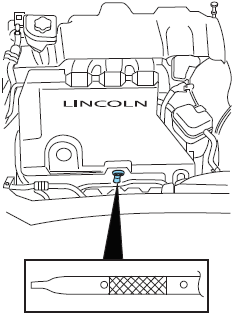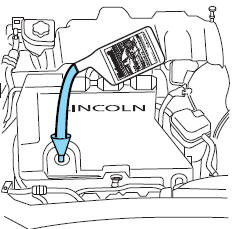Checking the engine oil

Refer to the scheduled maintenance information for the appropriate intervals for checking the engine oil.
1. Make sure the vehicle is on level ground.
2. Turn the engine off and wait 15 minutes for the oil to drain into the oil pan.
3. Set the parking brake and ensure the gearshift is securely latched in P (Park).
4. Open the hood. Protect yourself from engine heat.
5. Locate and carefully remove the engine oil level dipstick.
6. Wipe the dipstick clean. Insert the dipstick fully, then remove it again.


• If the oil level is within this range, the oil level is acceptable.
DO NOT ADD OIL.

• If the oil level is below this mark, engine oil must be added to raise the level within the normal operating range.

• If required, add engine oil to the engine. Refer to Adding engine oil in this chapter.
• Do not overfill the engine with oil. Oil levels above this mark may cause engine damage. If the engine is overfilled, some oil must be removed from the engine by an authorized dealer.

7. Put the dipstick back in and ensure it is fully seated.
See also:
2010 Lincoln MKT
While I wasn't crazy about its rear angle, the MKT looked great from the
front. It has a huge, aggressive grille that works well with the crossover's
size. It looks unique — in a good way.
The M ...
Checking automatic transmission fluid at cool temperature (59°F-77°F
[15°C-25°C])
If a fluid check is necessary at a low
fluid temperature (59°F-77°F
[15°C-25°C]), perform the check
using the cold range on the dipstick.
However, the fluid must be
re-checked at the proper ...
Adaptive headlamps
The headlamp beams move in the same direction as the steering wheel
which provides more visibility when driving around curves.
• Without adaptive headlamps (1)
• With adaptive headlamps (2)
...
